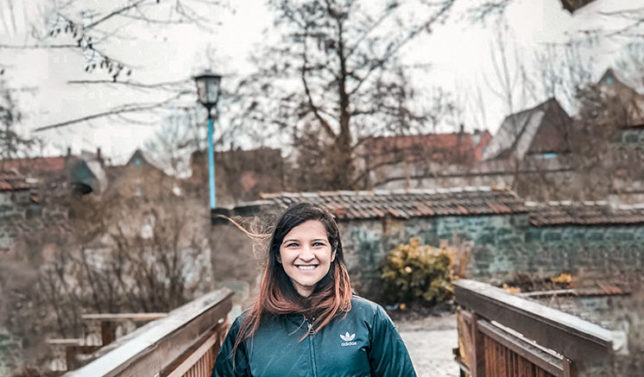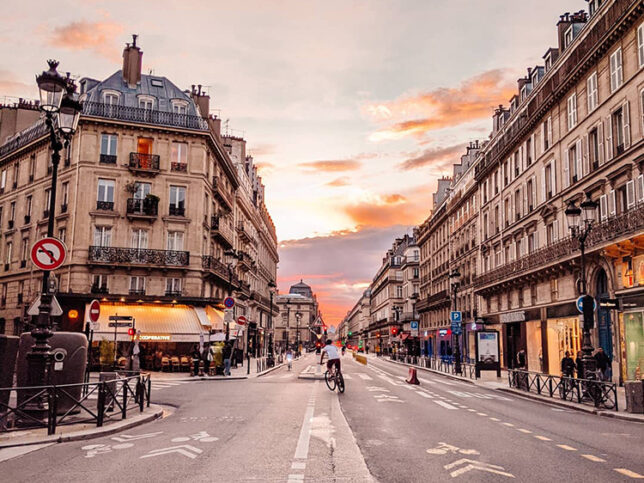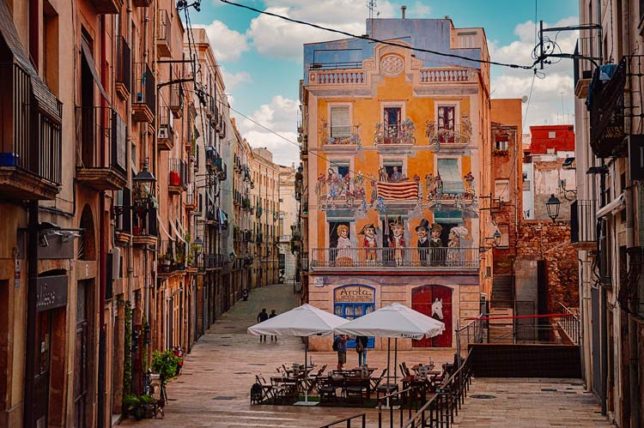Spending one day in Nuremberg? This guide will show you how to make the most of your time in the historic city.
While Bavaria has many wonderful places to offer, Nuremberg is a stand-out. The city has a rich history that is evident in its stunning architecture, its well-preserved old town, and its many museums.
I’ve lived here for over 4 years and still can’t get enough of the city. Maybe I’m biased (understandably so!), but I think Nuremberg is one of the most beautiful and underrated places in Europe.
If you’re thinking of visiting Nuremberg, or if you’re in Bavaria, I highly recommend spending a day – or longer – in the city to explore all it has to offer! Here’s a quick guide on how to make the most of your time in Nuremberg in one day.
IS NUREMBERG WORTH VISITING
Absolutely! Nuremberg is a charming city with plenty to see and do. It’s perfect for a day trip from Munich or Frankfurt, or for a longer weekend getaway.
Did you know that 90% of Nuremberg was destroyed in WWII? Despite this, the city has been meticulously rebuilt and restoration work is still ongoing. This makes for a fascinating mix of old and new.
Nuremberg played a strategic role in 20th-century European history. It was the site of the Nazi party rallies in the 1930s, and it was here that the Nuremberg trials were held after WWII. The city has many museums and memorials dedicated to this period of history, which offer a sobering but educational visit.
That being said, Nuremberg also has a lot to offer in terms of culture, art, food, and nightlife. There is lots to do in this Bavarian gem!
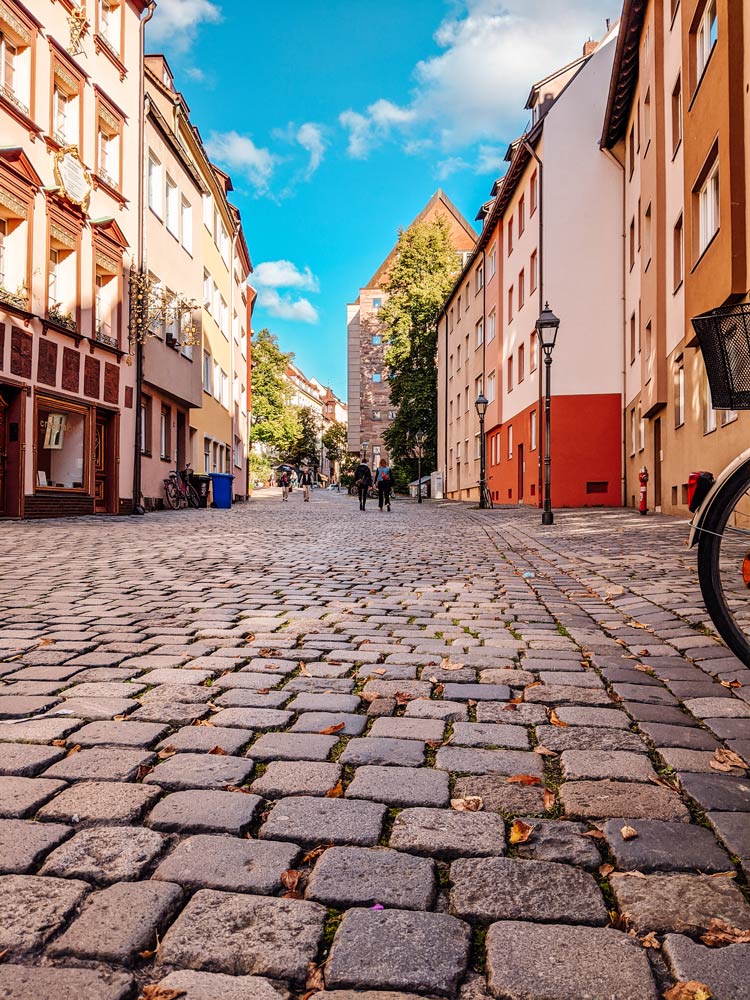
IS ONE DAY ENOUGH FOR NUREMBERG
For most people, one day is plenty of time to explore the city. Nuremberg is small and compact, making it easy to walk around and see the main sights.
If you want to see everything Nuremberg has to offer, I recommend spending at least two days in the city. This will give you enough time to visit the museums, go on guided tours, and explore the surrounding areas. Keep reading till the end of this article to find more things to do in Nuremberg if you’re staying longer.
BEST TIME TO VISIT NUREMBERG
The best time to visit Nuremberg is in the spring or autumn. The weather is milder, the crowds are thinner, and the city is exceptionally pretty in all its shades of red, orange, and green.
That being said, Nuremberg is worth visiting at any time of year. It snows quite a bit in the winter and the city looks beautiful wrapped in a blanket of white. And in the summer, you can enjoy the sunshine and outdoor beer gardens!
A particularly great time to visit Nuremberg is during the world famous Christmas market (Christkindlesmarkt). Held during the four weeks leading up to Christmas, the market is one of the largest and oldest in Germany. It’s the perfect place to stock up on lebkuchen, enjoy comforting mulled wine, and soak up on all the festive goodness.
HOW TO GET AROUND NUREMBERG
The best way to get around Nuremberg is on foot. The city center is small and very easily walkable, and most of the main sights are within walking distance of each other.
There’s also an efficient public transport system consisting of trams, buses, subways, and trains. A common ticket applies to all modes of transport, and can be purchased at train stations for EUR 3.10 or online on the VGN app for EUR 2.75.
If you’re planning on using public transport during your stay, I recommend getting a Nuremberg City Card. This gives you unlimited travel on all public transport in the city for 48 hours, as well as free entry to most museums and attractions.
WHERE TO STAY IN NUREMBERG
There are plenty of great places to stay in Nuremberg, depending on your budget and preferences.
If you’re looking for luxury, the Hotel Bayerischer Hof is a great option. You can get the full experience of living in a 17th-century hotel located directly on the Pegnitz river.
For something more affordable, you can try the Acomhotel or the Leonardo Hotel.
1 DAY IN NUREMBERG: ITINERARY AND THINGS TO DO
Altstadt (Old Town)
Start your day in the picturesque Old Town of Nuremberg. The River Pegnitz runs across the old town, which is full of red-roofed houses, cobbled streets, and medieval churches. On its north, the Old Town is dominated by the mighty Kaiserburg castle. On the south, you can see the formidable Lorenzkirche.
The Old Town used to be an important trade hub in the Middle Ages, and many of its buildings reflect this rich history. Most of the city’s attractions are in Altstadt, the main ones are covered below.
You’ll find yourself spending most of your 1 day in Nuremberg in this area, wandering through quaint alleyways and concrete bridges, and exploring the myriad things to do.
Hauptmarkt (Main Market)
Head to the Hauptmarkt, the central square of the Old Town, and one of the most popular tourist spots in Nuremberg. The square is ringed by grandiose patrician facades, and at its center, you’ll find the Schöner Brunnen (Beautiful Fountain). The 14th-century fountain is adorned with figures from Nuremberg’s history. It has a golden ring that is said to bring good luck to those who touch it.
Flanking the Hauptmarkt on its east is the imposing Gothic Frauenkirche (Church of Our Lady). Built in the 14th century, the church is one of the enduring symbols of the city. Frauenkirche was severely damaged during the Allied Bombings in WW2, but has since been restored to its former glory.
The Hauptmarkt is also the site of the world-famous Christkindlesmarkt, or the Nuremberg Christmas Market, which is held every year in the four weeks preceding Christmas.
Additionally, there are many other events and seasonal markets held in the Hauptmarkt throughout the year, like the Blaue Nacht (May), Bardentreffen (July), Herbsmarkt (September) and Ostermarkt (March).
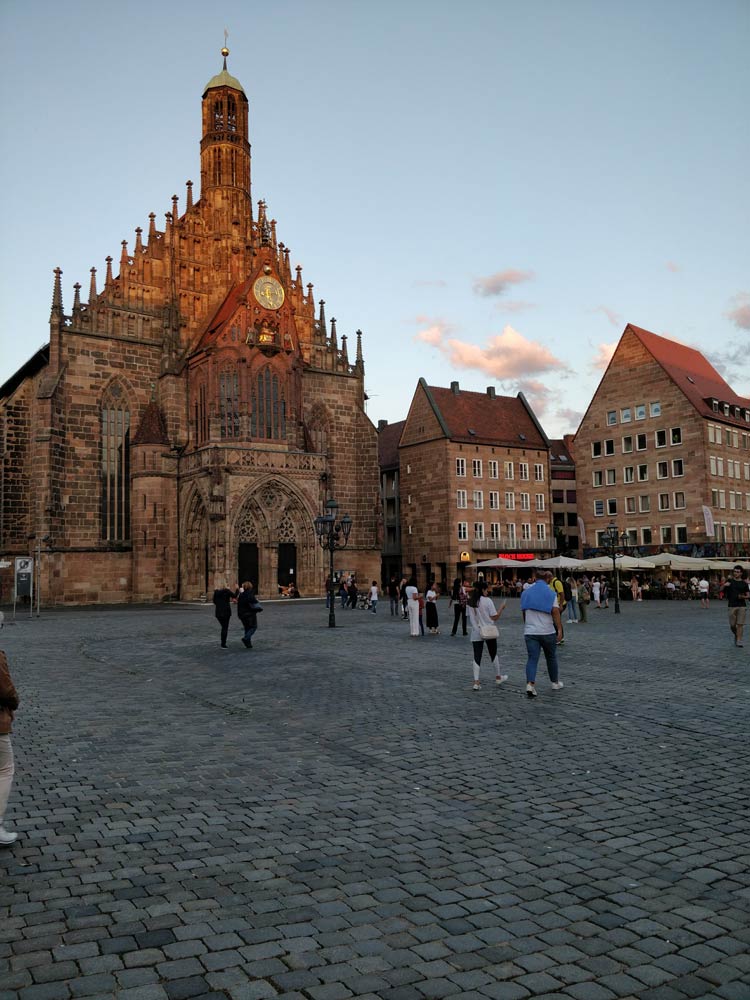
Bridges on the Pegnitz
A great way to see Nuremberg in one day while capturing the soul of the city, is to take a walk along the Pegnitz river. Throughout, the river is marked by a criss-crossing of bridges, both old and new. Each bridge holds an important place in the city’s history. Together, they give Nuremberg its unique, dreamy character.
The most iconic bridge in Nuremberg is the 400-year old Fleischbrücke (Meat Bridge), which was used to transport livestock to the city’s marketplaces. The late-Renaissance stone bridge has a small river island to its east, with Schlayerturm sitting in the middle.
Henkersteg (Executioner’s Bridge) is the oldest of Nuremberg’s bridges, dating back to the 12th century. The hangman (executioner) at the time took this bridge to get to the city from his secluded abode. Henkersteg lies near the Unschlittplatz, a beautiful square lined with half-timbered facades and a fountain in the center.
Maxbrücke was the first stone bridge to cross the Pegnitz river, and was built in the 14th century. While it was initially simply called the stone bridge, it got its current name to honor Bavarian king Maximilian I Joseph in 1810.
Lastly, Kettensteg (Chain Bridge) is the oldest surviving chain bridge in all of mainland Europe. It gets its name from the millions of chain links, each 3 meters long, on which the bridge is suspended.
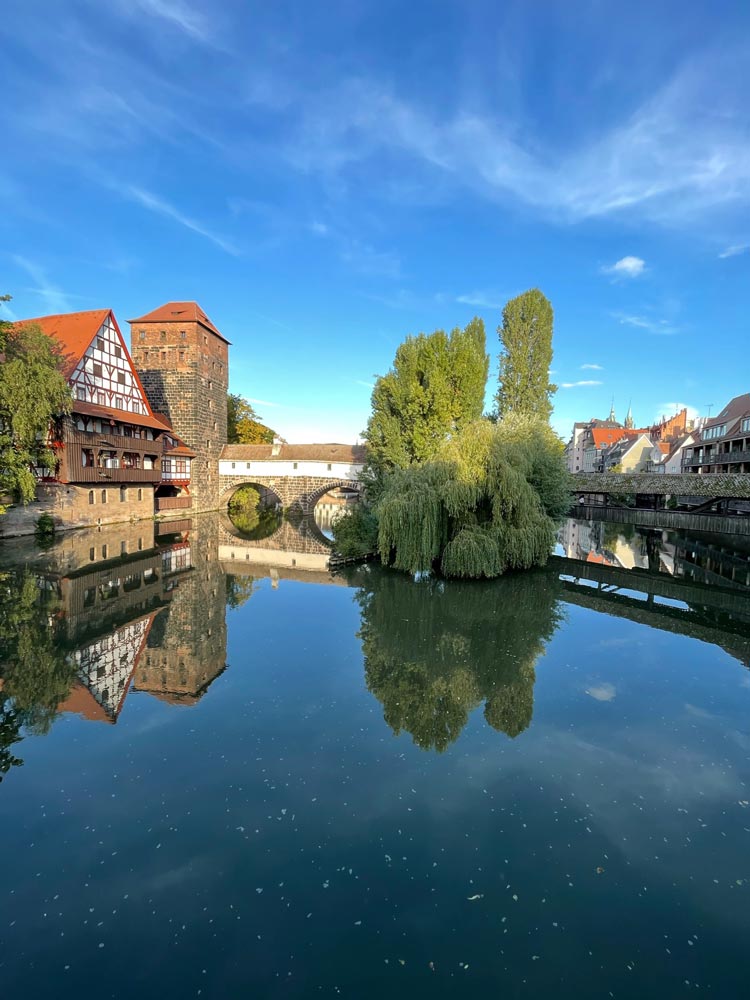
Sebalduskirche (St. Sebald)
Located on the Albrecht Durer Platz, St. Sebald church is one of Nuremberg’s oldest and most important landmarks. The double-spired Gothic church was built in honor of Sebaldus, Nuremberg’s patron saint. The interior of the church is quite austere, with few decorations. However, it more than makes up for this with its beautiful stained glass windows.
Built in 1225, Sebalduskirche suffered substantial damage during the World War, but it has now been restored. The church contains the tomb of Sebaldus, as well as the epitaph of the famous Tucher family.
Lorenzkirche (St. Lawrence)
Lorenzkirche is another of Nuremberg’s grand churches, and is the largest Protestant church in the city. The hall church is notable for its striking red sandstone exterior, as well as its massive twin spires.
Lorenzkirche was commissioned by Emperor Charles IV and built between 1352 and 1362. It is considered to be one of the most important Gothic churches in all of Germany.
The church’s interior is just as beautiful as its exterior, with a high vaulted ceiling and stained glass windows. The highlight of the church is its three-part organ, one of the largest in the world.
As you step out of Lorenzkirche, you’ll find yourself in the middle of one of Nuremberg’s most picturesque squares, the Lorenzer Platz. The square is ringed with beautiful half-timbered houses, and opens into Nuremberg’s Fashion Street lined with showrooms and restaurants. There are also street musicians and artists to keep you entertained.
Handwerkerhof
In the center of the city lies the Handwerkerhof, a quaint little courtyard that will transport you back in time. The half-timbered houses surrounding the courtyard were built in the 15th and 16th centuries for Nuremberg’s craftsmen and artisans.
The Handwerkerhof is the perfect place to take a break from all the walking and enjoy a traditional Franconian meal. You can also buy handicrafts, jewelry, and other souvenirs at the shops lining the courtyard.
Weißgerbergasse
Nuremberg’s old town is a warren of narrow, labyrinthine streets, and Weißgerbergasse is one of the most picturesque of them all.
Lined with half-timbered houses, cobblestones, and triple-paned windows in bold vivid colors – the street is a photographer’s (and an Instagrammer’s) dream come true.
Weißgerbergasse is also home to some of Nuremberg’s best bars and restaurants, as well as a number of small businesses. Some must-visits to add to your itinerary are:
- Die kleine Eismanufaktur: Probably the best gelato in the city
- Mata Hari: A cozy bar with a great selection of drinks and a really nice vibe
- Finyas Taverne in der Altstadt: Medieval style German restaurant with a unique, woodsy antique decor and good food.

Tiergärtnertor Area
As you exit Weißgerbergasse and turn towards Hallertor, you’ll see the imposing Tiergärtnertor, one of the remaining city gates. The gate was built in 1332 and is one of the most well-preserved medieval structures in Nuremberg.
On the Tiergärtnertorplatz which sits just off the gate, you’ll find many restaurants and cafes. This is also where you’ll find the former house of Albrecht Dürer, the world-famous Renaissance artist. The house is now a museum dedicated to the life and work of Dürer.
Imperial Castle of Nuremberg
Nuremberg Castle has been a witness to important events in German history. The castle was first built in the 11th century and has been expanded and renovated over the years. It was the residence of the Holy Roman Emperors during the Middle Ages.
Today, the castle is home to many historical buildings, as well as the Heidenturm (the old keep), and the Sinwellturm (the castle well).
The castle is located on a hill, so it’s a bit of a climb to get up there. But it’s definitely worth making it to the top, both for the views and the history.
From the castle grounds, you will be able to see the whole city of Nuremberg laid out before you. It’s a great spot to catch a sunset, with the red-roofed Old Town buildings within eyeshot.
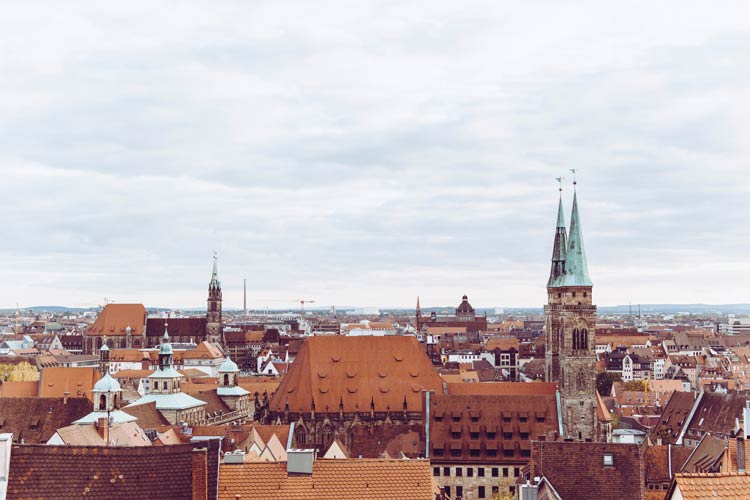
The museum inside the castle is also worth a visit – it has an impressive collection of art, weapons, and armor. You can take a guided tour to experience the castle in all its medieval glory.
Another little hideaway within the castle walls is the Burggarten. This castle garden was once the private playground of the castle’s residents, but is now open to the public. It’s a great spot to relax with a good book or just take in the peace and quiet.
Nuremberg City Walls
The city walls of Nuremberg are not just a historic relic – they also lend the city so much character.
The Imperial Castle, together with the city walls, constituted one of medieval Europe’s best fortification and defense establishments.
The walls run a length of 5 km in the Old Town, and were built in the 12th century. Presently, four tower gates mark the corners of the walls in the city. Outside the walls surrounding the Nuremberg castle, there is also a moat which is now used to host summer events and festivals.
Documentation Center and Nazi Party Rally Grounds
A less-known fact about Nuremberg is that it was the site of some of the most important Nazi propaganda events during the Third Reich.
Located a short distance outside the city center, the documentation center at the Nazi party rally grounds is a must-visit for anyone interested in learning about this dark period of history.
The center chronicles the rise of the Nazi party and its eventual fall, through a series of exhibitions and displays. It was here that the antisemitic race laws were drafted. There is also a section on the Nuremberg trials, which were held in the city after the war.
The documentation center is located on the site of the former Nazi party rally grounds. The enormous complex was designed by Albert Speer and was used to host the yearly Nuremberg rallies.
Within the complex is the Kongresshalle, or Congress Hall. Hitler’s dream project, this was intended to be a meeting place for up to 50,000 Nazi party members. It’s structure bore an eerie resemblance to Rome’s Colosseum. The hall was never completed due to the outbreak of WW2.
Visiting the Documentation Center is a sobering experience, but an important one, even if you’re in Nuremberg for just a day.
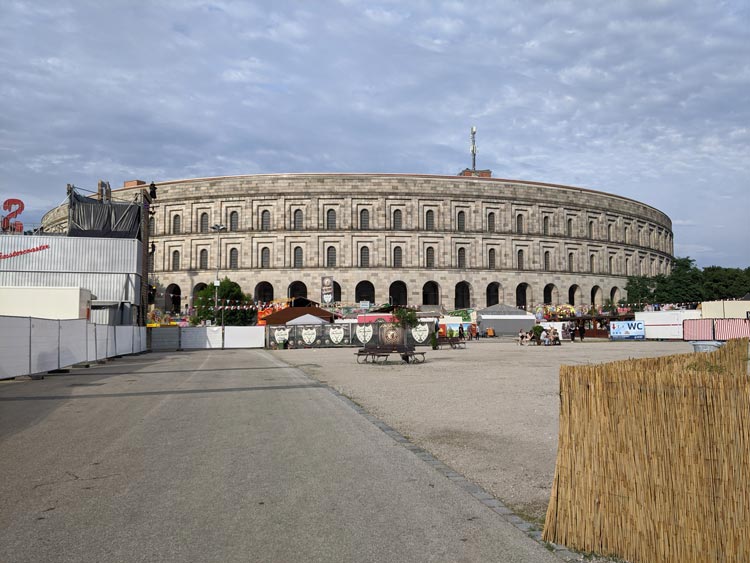
MORE THINGS TO DO IN NUREMBERG (LONGER THAN 24 HOURS)
If you have more than a day in Nuremberg, there is a lot more to do, from checking out museums to spending time in medieval cellars.
Toy Museum
Nuremberg is also home to the world’s oldest toy museum. The collection has over 15,000 toys and dolls, dating back to the 16th century.
The museum is located in the Old Town of Nuremberg, and is housed in a beautiful period building.
The museum’s collection includes dollhouses, teddy bears, puppets, and even a model of the Nuremberg castle. There is also a section on traditional German Christmas decorations and toys.
If you’re traveling with kids, the toy museum is a great option to keep them entertained. But even if you’re not, it’s a fascinating glimpse into the childhoods of people from centuries past.
DB Museum
The DB museum is a must-visit for anyone who’s interested in trains and railways.
The museum chronicles the history of the Deutsche Bahn (German railways), from its humble beginnings in the 19th century to its present-day incarnation.
The Deutsche Bahn is the second-largest transport company in the world, and has the largest railway and transport infrastructure in Europe.
Located close to Nuremberg’s main train station, the DB museum is easy to get to. Collections include old locomotives, carriages, and railway equipment. There is also a section on the famous Orient Express.
The museum is interactive and kid-friendly, making it a great option if you’re looking for something to do with the family.
Nuremberg Justice Court (Palace of Justice)
A visit to the Nazi Party Rally Grounds, supplemented with a trip to the Palace of Justice, would give you a well-rounded view of Nuremberg’s role in the Third Reich.
The Justice Court was the setting for the famous Nuremberg trials, in which 21 of the most key Nazi leaders were tried for war crimes between 1945 and 1946.
The court is now a museum, and houses a permanent exhibition on the Third Reich, the Nuremberg trials, and human rights. The exhibition is extremely elaborate, so make sure you set aside at least 2-3 hours for a visit.
As part of the guided tour, you can also visit the Courtroom number 600, where the trials were held. This is only accessible on weekends, though, as the courtroom is still in use for murder trials during the week.
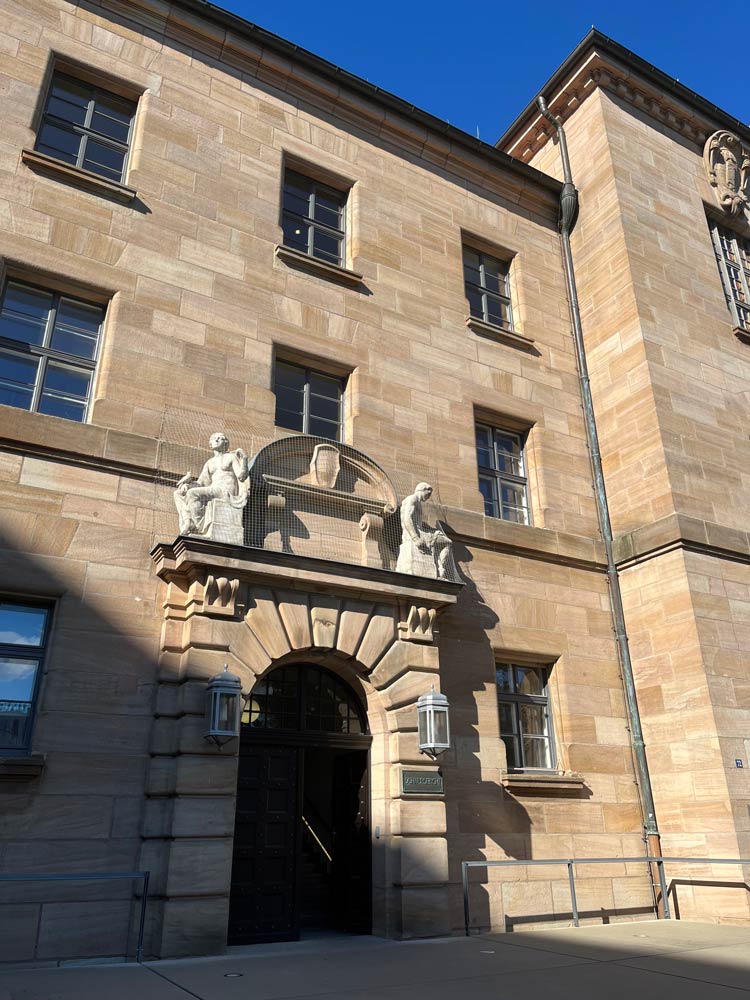
Medieval Dungeons
Nuremberg’s medieval dungeons are located beneath the city’s castle. They were used as a prison from the 14th to the 19th centuries.
The dungeon is not for the faint of heart – it’s dark, damp, and cramped. But it’s an interesting insight into the harsh reality of life in medieval times.
Inside, you’ll see cells, torture instruments, and other grim reminders of the past. In addition to the 2×2 meters prison cells, there is also the torture chamber which displays some of the torture devices used at the time.
The dungeon is only accessible as part of a guided tour. Due to the nature of the subject and exhibits, the tour is not recommended for small children. In fact, the minimum age to attend is 10 years.
Germanisches Museum
The Germanisches Museum is Germany’s largest museum of art and cultural history. It’s located in the city center of Nuremberg, close to the main train station.
The museum has an extensive collection of over 25000 items from the Stone Age to the present day. Highlights include clothing spanning several centuries, musical instruments, paintings, sculptures, and works of applied art.
There is also an extensive section on the history of science and technology. You can take a guided audio tour to journey through the museum and learn about the different exhibits.
Tiergarten Nuremberg (Zoo)
Nuremberg Tiergarten is located on the outskirts of the city, close to the Dutzendteich lake. It’s a great option if you’re looking to do something with the family.
The zoo houses over 300 animal species and spreads over an area of 67 hectares. It’s one of the largest zoos in Europe. You can get to see the Asiatic lions,Siberian tigers, Syrian brown bears, and Californian Sea Lions, among several other faunal species.
The zoo also has an aquarium with over 60 fish tanks. You can see sharks, rays, piranhas, and turtles up close. Guided tours are available for the zoo. I’m a bit torn on the ethics of zoos, so I’ve never made a trip up to the Nuremberg Tiergarten, but I’ve heard the animals are kept in their natural habitat and are not ill-treated in any way. So it may be worth a visit if you are in Nuremberg!
DAY TRIP TO NUREMBERG FROM MUNICH
Nuremberg makes for a popular day trip from Munich, as it’s only an hour away by train and 2 hours by bus.
To travel to Nuremberg from Munich by train, you can take the direct ICE train from Munich Hauptbahnhof (central station). The journey takes around 1 hour. A slightly cheaper option is the Regional Express (RE) train, which makes a few stops en route but is still relatively fast. It takes about 1.5-2 hours.
If you’re on a budget, you can take the Flixbus from Munich to Nuremberg. The journey takes a bit longer (2 hours), but tickets start at under 10 euros.
Once you arrive in Nuremberg, you can explore the city on foot or by public transport. Like I mentioned earlier, the city center is very walkable, and so you can see it all in a day and head back to Munich on the last train or bus of the day.
OR you could take a guided tour from Munich to Nuremberg. A local guide will keep you company and share tons of fun facts and interesting insider tips ahead of your visit!
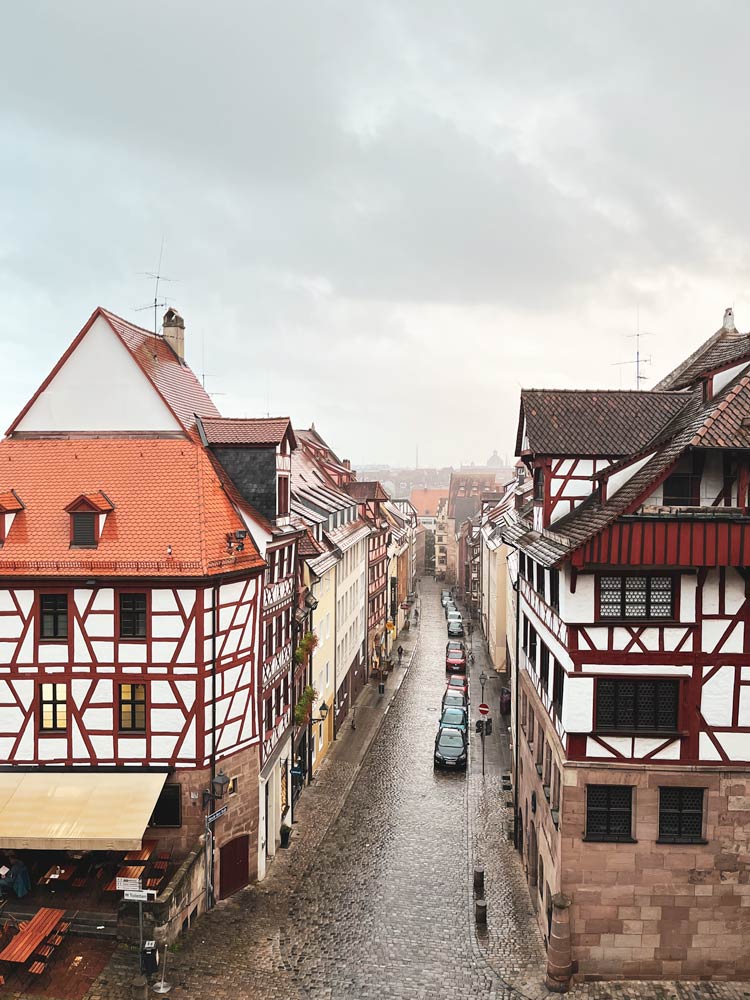
Visiting Nuremberg soon? Check out these articles about day trips nearby:
Day Trip to Rothenburg, Germany
How to Plan an Epic Road Trip on the Romantic Road


